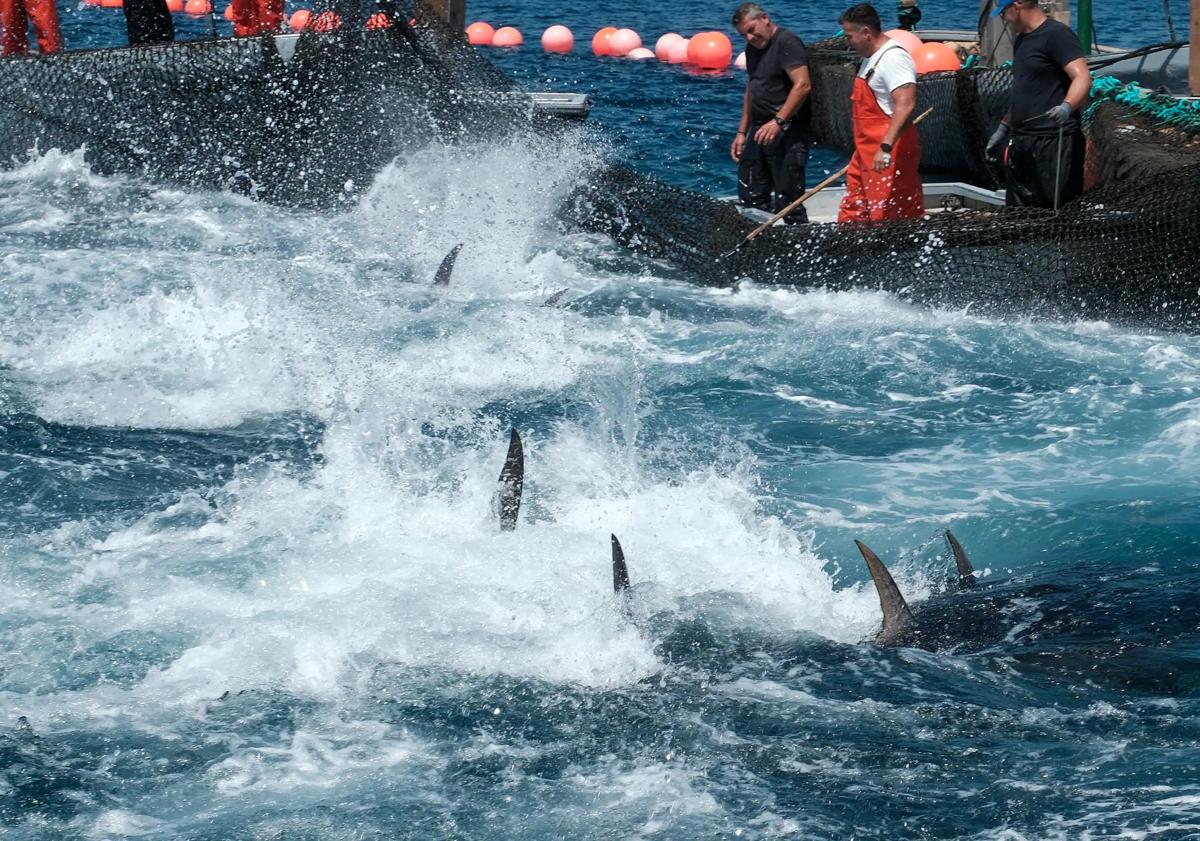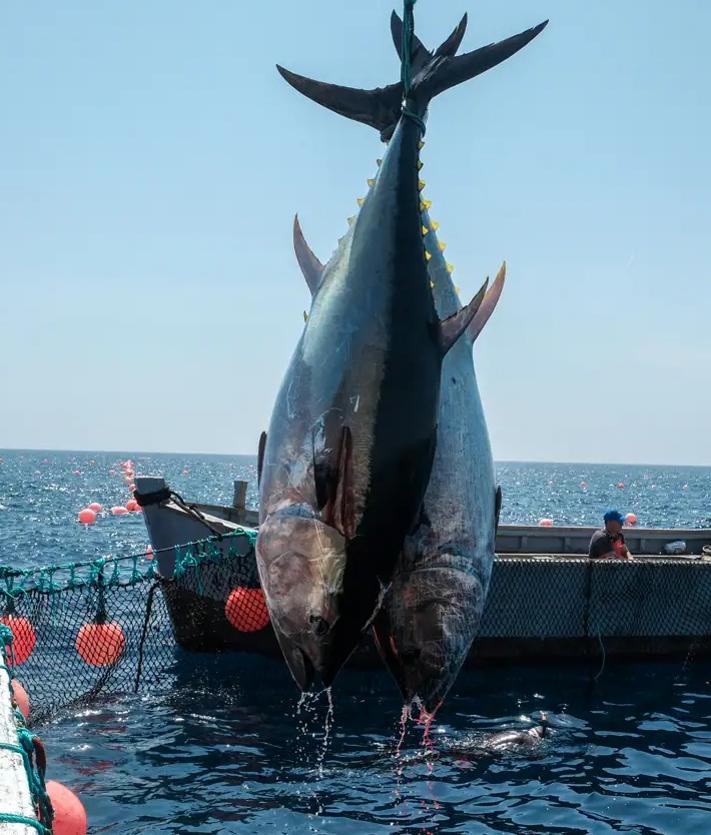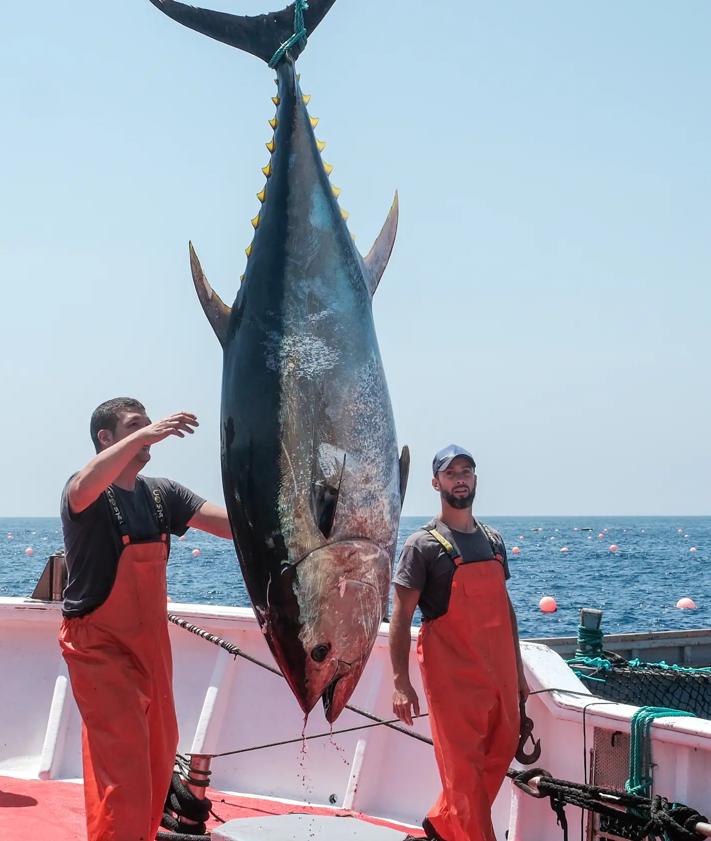

Sections
Highlight

Jesús Mejías
Barbate
Sunday, 21 April 2024, 08:41
The red gold that is bluefin tuna returns home. The Cadiz company Petaca Chico celebrated its first 'levantá' - literally, the hoisting of tuna fish after being corralled by boats and nets (almadrabas) - of 2024 on Thursday 18 April and thus the trapping season was opened for business in the waters of Barbate.
On this first day of fishing with the Barbate traps around thirty specimens were caught, some of them weighing close to 400 kilos. One of the first tuna landed weighed 373 kilos. The first specimen of the season was, as per tradition, bound for the El Timón de Roche restaurant. The renowned hospitality business already counts on the bluefin tuna from the traditional Barbate 'almadrabas' of the Petaca Chico company, also from Cadiz, for the name is without doubt synonymous with quality.
The first tuna was caught at 1.45pm, as it must coincide with high tide to facilitate the work in the traps and this resulted in the capture of 30 specimens of wild bluefin tuna Thunnus thynnus and all a very good size. The largest fish was 380 kg. Immediately after the tuna were caught in the almadraba, they were transferred to Petaca Chico's processing plant, where the master netters proceeded to cut them up for a swift sale.
It was a day of emotions and a day of nerves, as Pedro Muñoz, CEO of Petaca Chico, acknowledged. "The first day is always unique, it's the most exciting day, it's the start of a new fishing season, a new league as we say and we are very excited to land the first tuna as it's something special".
Although the first Barbate 'levantá' took place on 18 April, the prep work began months ago. "Since mid-January, the crews have been working preparing all the equipment we need", and "in March we started going out to sea to place the buoys, all the cabling and the nets to trap the tuna".



This is a very traditional style of fishing, it's been around for three thousand years and is still going strong. During the bluefin tuna's migration from the Atlantic Ocean to the warmer waters of the Mediterranean Sea to spawn, the 'almadraberos' (trappers) catch some of these fish. The tuna, during their journey, will arrive at the 'calamento' - the network of nets set up by the almadraberos to catch them. Once inside, they pass through a series of several nets until they reach the 'copo', a kind of pool with a net at the bottom that is hoisted up by the crews and into which the divers enter to catch the tuna.
Divers use a lupara located on a pole and, when the diver puts pressure on the tuna's head, it triggers a charge to be fired, instantly killing the animal so there is no suffering.
Petaca Chico forecasts "we are confident that this season will be good" and even "better than last year" in which "we had many problems with the market and it didn't go too well, but we hope that this year will be much better, we are confident that there will be a lot of tuna".
The four almadrabas in the province of Cadiz can net a total of 1,643.167 tonnes. The one in Barbate (Petaca Chico) is allocated up to 454,124 tonnes, the one in Conil 426,325 tonnes, the one in Tarifa 349,454 tonnes and the one in Zahara de los Atunes 413,264 tonnes.
This quota is allocated by ICCAT, the International Commission for the Conservation of Atlantic Tunas, although "we are allowed to purchase quotas from other fisheries that are not going to make use of them", that is, they can buy the quota of a fishery in the Basque Country or Asturias and catch fish in Barbate using that quota. This formula has been used in the past and has not been ruled out for 2024, which could raise the final quota for Petaca Chico by approximately 800 tonnes.



In striking contrast to the early years of the 21st century, nowadays "90% of our tuna is destined for the national and EU market" , while Japan, a country that had previously been a major buyer of the species, "is left with approximately 10%". These figures reflect the growth of the bluefin tuna market closer to home, a species that is becoming increasingly popular and more visible in Spanish restaurants.
Petaca Chico is one of the leading companies in the fishing industry with over 30 years of experience and a leading light in the world of wild bluefin tuna. They do sell other fresh fish, cephalopods (cuttlefish, squid, octopus for example) and different varieties of tuna. They currently sell to more than 25 countries, mainly through large supermarket chains, and they have three production plants totalling 20,000 m2 in size with -25º and -60º cold storage facilities in the town of Conil and Cadiz city. Petaca Chico has turned sales of Almadraba bluefin tuna from Barbate into a year-round business. During the tuna fishing season, they sell the tuna fresh, and throughout the rest of the year they distribute almadraba tuna deep-frozen at -60 degrees so that it retains all its properties and flavour.
The company's CEO Pedro Muñoz acknowledges that "company growth has been tremendous. Twenty years ago, Petaca Chico had around 16 to 20 workers, today, between Petaca's own companies and those of our partners, we have more than 600 people".
On one day of the 'levantá' alone, "around seventy almadraberos work at sea", although "there are also people who work as transporters and in the ice factories, etc.".
It should be noted that tuna fishing here generates approximately 500 direct jobs and 6,000 indirect jobs.
The history of bluefin tuna fishing in Barbate is as old as the history of the province of Cadiz itself, and bears the same origins - from the Phoenicians. The art of catching this red gold from the sea is still alive today and has been passed down from generation to generation for centuries.
The first evidence of bluefin tuna trapping dates back to the 8th century BC. The Phoenicians were the driving force behind the technique, which was later imitated by the Romans who settled in the city of Baelo Claudia. Around the 2nd century BC, bluefin tuna fishing experienced a golden era as it became a commercialised industry, and some documents from that period state that there were years in which 140,000 tuna were caught. In 2023 Petaca Chico caught 6,000.
From the time of the Muslim invasion of the Peninsula there is hardly any record of activity, but after the defence of the town of Tarifa by Guzmán 'el Bueno', King Sancho IV granted him a monopoly on bluefin tuna fishing in the waters off the coast of Cadiz. Then, going under the name of the Dukes of Medinaceli, the family continued to profit from bluefin tuna, providing them with a significant annual income. By the 18th century the dukes wanted to hand this privilege back to the crown, but that never happened.
In 1928, the Consorcio Nacional Almadrabero was created in order to rationalise and control bluefin tuna fishing, but the consortium was later dissolved in 1971. By 1975, however, the almadraba fisheries sorted out their business dealings and this led to the founding of OPP51 in the year 2000 - the Organización de Productores Pesqueros de Almadraba - an industry association to manage tuna fishing by almadrabas in a reasonable, sustainable manner for future generations.
Publicidad
Publicidad
Publicidad
Publicidad
Esta funcionalidad es exclusiva para registrados.
Reporta un error en esta noticia

Debido a un error no hemos podido dar de alta tu suscripción.
Por favor, ponte en contacto con Atención al Cliente.

¡Bienvenido a SURINENGLISH!

Tu suscripción con Google se ha realizado correctamente, pero ya tenías otra suscripción activa en SURINENGLISH.
Déjanos tus datos y nos pondremos en contacto contigo para analizar tu caso

¡Tu suscripción con Google se ha realizado correctamente!
La compra se ha asociado al siguiente email
Comentar es una ventaja exclusiva para registrados
¿Ya eres registrado?
Inicia sesiónNecesitas ser suscriptor para poder votar.